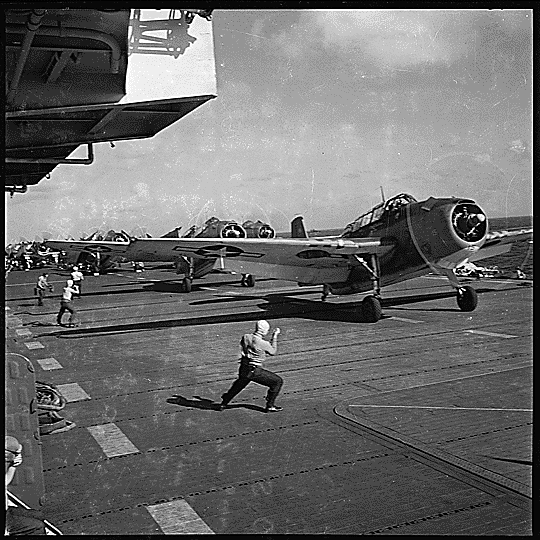Before dawn on February 17, the fleet carriers of Task Force 58 launched F6F Hellcats in order to clear the skies of hostile aircraft. Truk had been closed to non-Japanese for decades, and the pilots were flying into an enemy sky about which very little was known. The reconnaissance flight over the lagoon had shown a high concentration of warships and ground based attack aircraft which would have to be controlled if Hailstone was to be successful, and the Hellcat pilots must have expected fierce resistance and heavy losses.
Arriving over target at first light, the fighters found the the skies and lagoon below nearly unprotected. The Japanese Combined Fleet had vanished and although the airfields on Moen and Param were scrambling to launch a defence, the American pilots ruled the air above Truk.

An F6F Hellcat readies on the flight deck.
CAP provided the primary defence over the Task Group. The light carriers
launched F6Fs to maintain continuous air cover for the warships. Essex pilot Hamilton McWhorter, who became a double ace at
Truk, flew CAP during his uneventful first mission. Later he flew a
photographic mission, during which he took time out to strafe the
Japanese destroyer Tachikaze, which was grounded on Kuop
Atoll a few miles south of Truk. He then engaged and shot down three
Japanese aircraft, which brought his confirmed total to ten kills. Strike A
As the Fighters began their engagement over Truk, the first air strikes left the fleet carriers were launching bombers intended to destroy shipping and shore installations within the lagoon. The Dauntless dive bombers and Avenger torpedo bombers were armed with armor piercing bombs for the warships expected to be operating in the waters around Truk, as well as incendiary and fragmentation clusters to destroy aircraft on the ground. A fighter group was formed to escort the bombers over their targets.

SB2C Helldivers over the Bunker Hill.
National Archives photo.
Strike B
The second strike of February 17 was very much like the first, and was also intended to hammer Truk's defences.

Avenger TBFs Staging on the deck on the Monterey.
Strike C
Word of a convoy escaping through North Pass had reached the Task Group by the time that the third strike was being armed for their mission. Consequently, the bombers were armed with armor piercing bombs to take on the hardened warships. The flight was vectored to intercept the light cruiser Naka, the destroyer Nowaki and the auxiliary subchaser Shonan Maru.
Planes from earlier strikes had been recovered by now and pilots had been debriefed. Since it was clear that the Japanese Fleet had abandoned Truk and few major warships could be targeted, the bombers were loaded with general purpose bombs. These bombs carried more explosive payload than the anti-ship armor piercing bombs and were more effective against soft targets such as the auxiliary ships in the lagoon and the shore facilities. Tactics shifted to neutralizing Truk as an effective base of operations.
As the sun settled into the western sky the focus of the attacks changed to ensuring that no Japanese planes would be able to attack the task force during the night. As a result, fragmentation bombs were dropped into the remaining Japnese aircraft on the ground to assure that they couldn't be repaired quickly. Also, time delay fuses of up to several hours were used in the general purpose bombs targeted at the airfields to keep the runways out of action. The random detonation of ordinance made clearing the airfields a dangerous and time consuming task.
Click here to return to the main Operation Hailstone webpage.The final strike of the first day was also designed to eliminate Truk's ability to mount a night offensive.
Dusk settles on Task Force 58. Gun crews and deck personnel await the return of Strike F.
